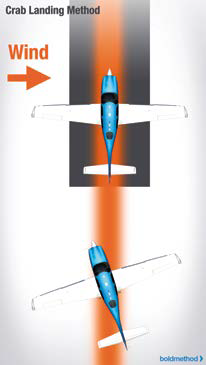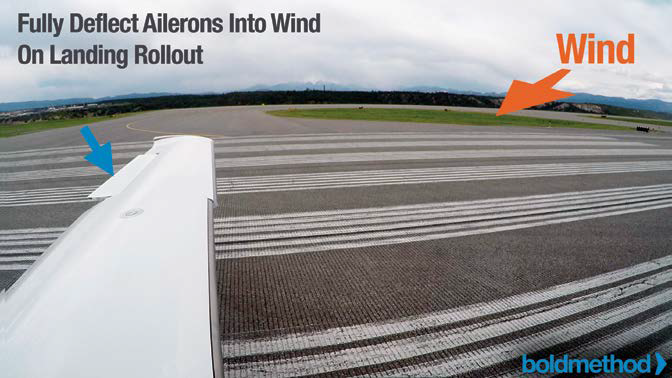You’re picking up ATIS as you’re inbound for landing. The winds are 23 knots, 40 degrees off runway heading; and your passengers are expecting a landing they can walk away from.
Crosswind landings can be one of the most stressful things for pilots, especially if you haven’t practiced them in a while. And whether you’re a new pilot just learning to fly, or a 20-year pilot who hasn’t gotten a lot of practice recently, a little review can go a long way.
Choose Your Method
When it comes to crosswind landings, there are two primary methods you can use: crab and wing-low. There are advantages and disadvantages to both. They’re really the same method as you touch down, but the difference comes down to when you start your transition to the wing-low slip.
Flying the Crab Method

With the crab technique, you fly final approach crabbing into the wind to prevent drifting left or right of centerline. You maintain the crab all the way to your flare, and just before touchdown, you step on the rudder to align your nose with the runway and use ailerons to prevent drifting with the wind.The crab technique can be an easy way to maintain centerline on final approach, but it requires quite a bit of judgment and timing to “kick out” the crab just before touchdown. This is the same technique that jets use to land. But there’s a big difference between a 737 and a single-engine piston, and that’s inertia. If a 737 isn’t perfectly aligned with the runway on touchdown, it straightens itself out as the wheels touch down, and it keeps rolling smoothly down the runway. But if your Cirrus isn’t aligned with the runway at touchdown, you’re going to jump and bounce across the pavement until you are aligned with it. So unless you’re out practicing your crab-to-touchdown a lot, it can be a tough method to perfect in a light plane.
Flying the Wing-low Method
In most light aircraft, the wing-low method is an easier way to accomplish a smooth touchdown in a crosswind landing.
To fly the wing-low method, you use your rudder to line your nose up with the runway, and ailerons to correct for left/ right drift all the way from final approach to touchdown. Essentially, you’re slipping the plane through the crosswind in order to keep yourself lined up with the runway from final to touchdown.
You start flying the wing-low method on final approach. Depending on how comfortable you are flying the technique, you can transition to the wing-low method early during your final approach, or you can transition to it as you approach the runway threshold. The choice is yours.


Getting used to flying wing-low can take a little practice to get comfortable with because you’re cross-controlling the aircraft in order to stay aligned with the runway. Stepping on the rudder in one direction to keep your nose aligned with the runway and using ailerons in the other direction to prevent drift can feel confusing at first. And it’s easy to get the two mixed up when you’re starting out.
One of the best ways I’ve found for students to learn to fly wing-low is by breaking the maneuver down into two parts. First, step on the rudder to get the nose aligned with the runway. Second, use ailerons to stop drifting left or right, and keep yourself aligned with the runway centerline.
Another good way to get used to the wing-low method is by flying a low approach over the runway and never touching down. By flying all the way down the runway, you give yourself the chance to keep the nose aligned with the runway, and you can really practice your drift correction.
After a few trips around the pattern, you’re able to start combining the rudder and ailerons effortlessly and get yourself established on a perfect winglow final approach. Just remember that you use the rudder to keep the nose aligned with the runway, and you use the ailerons to prevent your plane from drifting left or right.
Wing Low: Round Out and Flare
As you begin your round out and flare, your airplane slows down, which also means your flight controls are less effective. Because your flight controls are less effective, you need to add more rudder to keep your nose aligned with the runway. At the same time, you need to add more aileron to keep yourself from drifting off the centerline.
As you add control inputs, you want to keep your upwind wing low the entire time, because you’re about to touch down.

Touchdown
As you touch down in the crosswind, you want to do it in three steps: first, the upwind main, then, the downwind main, and finally, the nose wheel.
By touching down one wheel at a time, you maintain your alignment with the runway throughout the touchdown.
After-landing Rollout

After you touch down, you need to prevent your airplane from weathervaning into the wind. To do that, slowly add full aileron deflection into the wind, and keep it there throughout your rollout. At the same time, use your rudder to stay on centerline.
You’ll find that by keeping your ailerons fully into the wind, your upwind wing won’t lift up, even in gusts, and it’s much easier to maintain control of your airplane throughout the rollout.
What's the Maximum Safe Crosswind Velocity for Landing?
When it comes to crosswind, how much is too much? It really depends on your experience level and how much practice you get.
Almost all airplanes you fly have a “demonstrated crosswind” capability, which is in knots. The FAA requires a certified airplane’s crosswind capability demonstration to “being satisfactorily controllable with no exceptional degree of skill or alertness on the part of the pilot in 90-degree crosswinds up to a velocity equal to 0.2 VSO.” That means a wind speed of at least 20% of the airplane’s stalling speed with power off and landing gear/flaps down.
For example, the Cirrus SR22T G6 has a maximum demonstrated crosswind of 21 knots. Keep in mind that this doesn’t mean you aren’t allowed to land in more than 21 knots of crosswind. But if you do have more crosswind than that, you’re going to need to use, as the FAA puts it, a more “exceptional degree of skill” to touch down safely. And obviously, if you’re flying final and you aren’t able to keep the nose aligned with the runway using full rudder, you’re well beyond the crosswind capabilities of your plane. If that’s ever the case, you’ll need to pick a more favorable runway, or a different airport.
Using the Method That Works for You
Finding the landing method that works best for you comes down to trying both out, as well as some repetition.
In most cases, the wing-low method is easier in light aircraft. To fly it, keep your nose aligned to the runway with your rudder, and use your ailerons to prevent drift.
With some time and practice in your airplane, you’ll have the method down, and you’ll be ready to make the perfect crosswind landing.
This article was initially published in the July 2020 issue of COPA Pilot